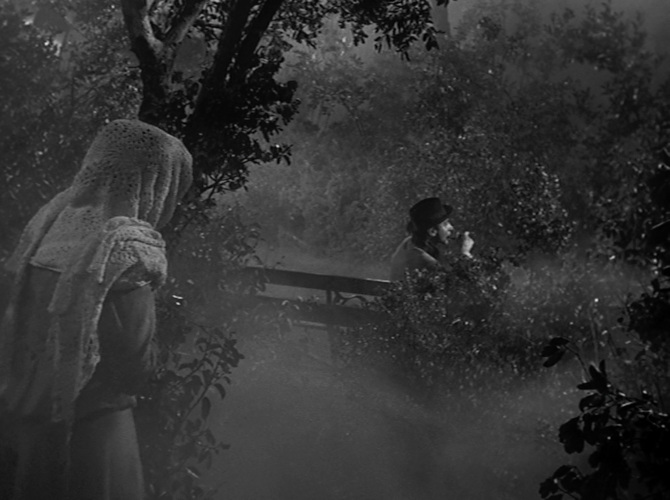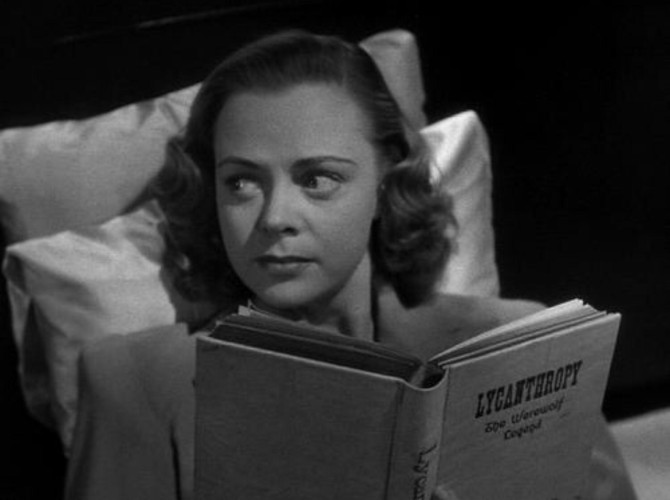Taking a more melodramatic angle of the horror genre, towards the end of Universal’s golden age of scary movies comes 1946’s She-Wolf of London, directed by Jean Yarbrough – a change of pace from the Lon Chaney Jr. led Universal features (he had already played the Wolf Man four times to this point, and would soon do so one last time in Abbott and Costello Meet Frankenstein).
A period piece set in London, horrific murders continue to take place in a local park near the wealthy estate of the Allenby’s. Long rumoured to be cursed, the last vestige of the line is Phyllis Allenby (June Lockhart), a young, nervous woman who, instead of cheerfully planning her wedding to barrister Barry Lanfield (Don Porter), frets about the growing number of deaths in the vicinity – wondering if these acts might have been unknowingly done by her very own hand.
Cared for by her Aunt Martha Winthrop (Sara Hagen), and close to her cousin Carol (Jan Wiley), who also lives on the estate, they are relatives in name only. . . a semi-scandal that has long been hidden by Martha from her daughter. Wielding the manor with an iron fist, she keeps kindly maidservant Hannah (Eily Malyon) in line, while also attempting to curb the young love her daughter has for a lowly German artist who is attempting to court her.
But not to worry, Detective Latham (Lloyd Corrigan) is on the case, an officer who has clearly gone to the Dr. Watson school of bumbling tomfoolery. He is the only one who believes that these murders are not by the hands of some sort of wild animal or even wilder human being, but instead by a ravenous werewolf. Of course, his superior, Inspector Pierce (Dennis Hoey), thinks it is utter nonsense, as do most of Scotland Yard patrolling the park at night.
As the bloody murders continue, poor Phyllis descends further and further into her own fragile psyche, pushing away her beloved lawyer in favour of isolation and macabre readings of her possible condition. Meanwhile, cousin Carol spends more time with lawyer Barry, the man stymied by the constant rebuffs. Will Phyllis be able to snap herself out of her fugue-like reveries of folkloric curses and bloody murder? Is there an actual reason for all these attacks? Could it actually be some sort of werewolf, or is that just ludicrous?
A kind of love to hate it film for horror purists, Yarbrough and his team lean further into the melodramatic period piece family angle rather than the horror. Audiences expected Lon Chaney-like scares, which only come very fleetingly as we see a mysterious figure creeping around in white, ripping out the throats of nighttime park goers. The rest is all mood and mystery, with tilted Dutch angles, foggy nights, the howls of antsy hounds, the whispers of nervous people, and the drama that unfolds in and around the luxurious Allenby estate. All of this comes to mean that this is a much slower paced talking piece than anything else. But it is still worth noting that Lockhart does a fantastic job as the young woman with a tortured psyche, the audience truly sensing her nerves being in a tizzy.
Still a worthwhile watch despite it lacking very many horror moments (it really would have been better advertised as a mystery), She-Wolf of London was actually released as a double bill with The Cat Creeps (which was reviewed here on Filmizon.com earlier this Halloween season), making it more attractive to independent theatre chains who might think purchasing a singular B movie isn’t worth the deal. So, discover who or what haunts this family estate, it just might surprise you.



